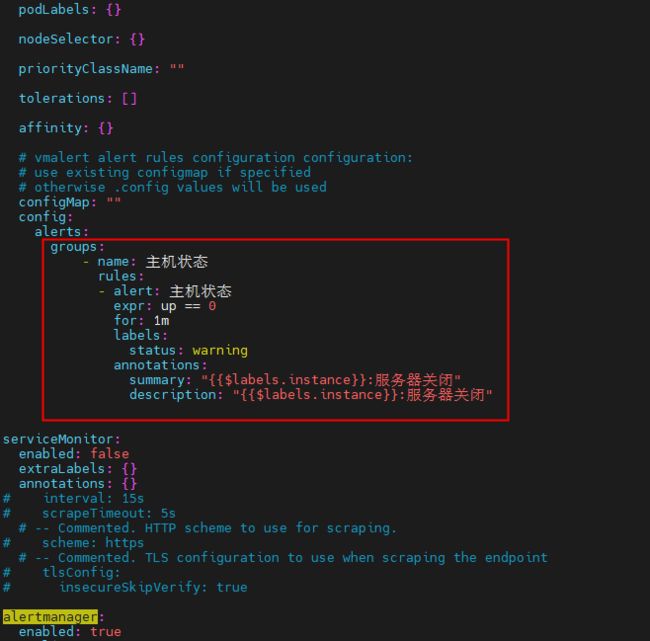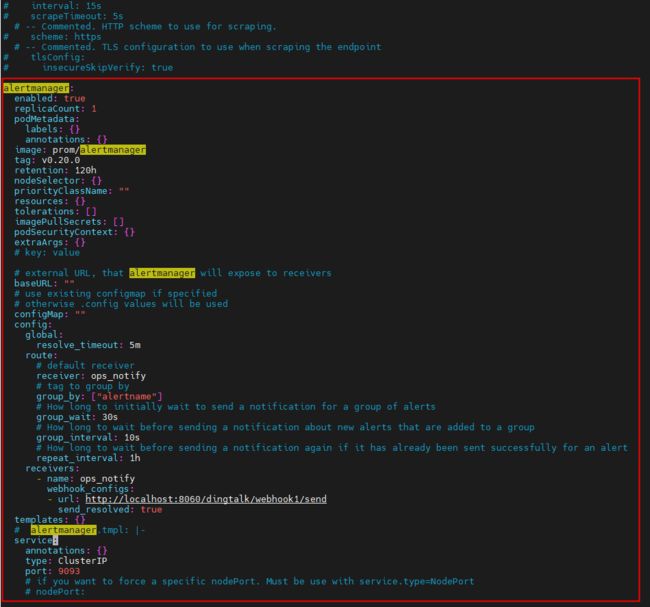helm部署vmalert
先决条件
安装以下软件包:git, kubectl, helm, helm-docs,请参阅本教程。
在 CentOS 上启用 snap 并安装 helm
启用 snapd
- 使用以下命令将 EPEL 存储库添加到您的系统中:
sudo yum install epel-release- 按如下方式安装 Snap:
sudo yum install snapd- 安装后,需要启用管理主 snap 通信套接字 的systemd单元:
sudo systemctl enable --now snapd.socket- 创建软链/snap:
sudo ln -s /var/lib/snapd/snap /snap- 注销并重新登录,或重新启动系统,以确保正确更新 snap 的路径。
安装 helm
使用以下命令安装 helm:
sudo snap install helm --classic安装victoria-metrics-alert
- 使用以下命令添加图表 helm 存储库:
helm repo add vm https://victoriametrics.github.io/helm-charts/
helm repo update- 列出vm/victoria-metrics-alert可供安装的helm版本:
helm search repo vm/victoria-metrics-alert -l- victoria-metrics-alert将图表的默认值导出到文件values.yaml:
helm show values vm/victoria-metrics-alert > values.yaml根据环境需要更改values.yaml文件中的值。
[root@bastion ~]# cat values.yaml
# Default values for victoria-metrics-alert.
# This is a YAML-formatted file.
# Declare variables to be passed into your templates.
serviceAccount:
# Specifies whether a service account should be created
create: true
# Annotations to add to the service account
annotations: {}
# The name of the service account to use.
# If not set and create is true, a name is generated using the fullname template
name:
# mount API token to pod directly
automountToken: true
imagePullSecrets: []
rbac:
create: true
pspEnabled: true
namespaced: false
extraLabels: {}
annotations: {}
server:
name: server
enabled: true
image:
repository: victoriametrics/vmalert
tag: "" # rewrites Chart.AppVersion
pullPolicy: IfNotPresent
nameOverride: ""
fullnameOverride: ""
## See `kubectl explain poddisruptionbudget.spec` for more
## ref: https://kubernetes.io/docs/tasks/run-application/configure-pdb/
podDisruptionBudget:
enabled: false
# minAvailable: 1
# maxUnavailable: 1
labels: {}
# -- Additional environment variables (ex.: secret tokens, flags) https://github.com/VictoriaMetrics/VictoriaMetrics#environment-variables
env:
[]
# - name: VM_remoteWrite_basicAuth_password
# valueFrom:
# secretKeyRef:
# name: auth_secret
# key: password
replicaCount: 1
# deployment strategy, set to standard k8s default
strategy:
type: RollingUpdate
rollingUpdate:
maxSurge: 25%
maxUnavailable: 25%
# specifies the minimum number of seconds for which a newly created Pod should be ready without any of its containers crashing/terminating
# 0 is the standard k8s default
minReadySeconds: 0
# vmalert reads metrics from source, next section represents its configuration. It can be any service which supports
# MetricsQL or PromQL.
datasource:
url: "http://192.168.47.9:8481/select/0/prometheus/"
basicAuth:
username: ""
password: ""
remote:
write:
url: ""
read:
url: ""
notifier:
alertmanager:
url: "http://192.168.112.68:9093"
extraArgs:
envflag.enable: "true"
envflag.prefix: VM_
loggerFormat: json
# Additional hostPath mounts
extraHostPathMounts:
[]
# - name: certs-dir
# mountPath: /etc/kubernetes/certs
# subPath: ""
# hostPath: /etc/kubernetes/certs
# readOnly: true
# Extra Volumes for the pod
extraVolumes:
[]
#- name: example
# configMap:
# name: example
# Extra Volume Mounts for the container
extraVolumeMounts:
[]
# - name: example
# mountPath: /example
extraContainers:
[]
#- name: config-reloader
# image: reloader-image
service:
annotations: {}
labels: {}
clusterIP: ""
## Ref: https://kubernetes.io/docs/user-guide/services/#external-ips
##
externalIPs: []
loadBalancerIP: ""
loadBalancerSourceRanges: []
servicePort: 8880
type: ClusterIP
# Ref: https://kubernetes.io/docs/tasks/access-application-cluster/create-external-load-balancer/#preserving-the-client-source-ip
# externalTrafficPolicy: "local"
# healthCheckNodePort: 0
ingress:
enabled: false
annotations: {}
# kubernetes.io/ingress.class: nginx
# kubernetes.io/tls-acme: 'true'
extraLabels: {}
hosts: []
# - name: vmselect.local
# path: /select
# port: http
tls: []
# - secretName: vmselect-ingress-tls
# hosts:
# - vmselect.local
# For Kubernetes >= 1.18 you should specify the ingress-controller via the field ingressClassName
# See https://kubernetes.io/blog/2020/04/02/improvements-to-the-ingress-api-in-kubernetes-1.18/#specifying-the-class-of-an-ingress
# ingressClassName: nginx
# -- pathType is only for k8s >= 1.1=
pathType: Prefix
podSecurityContext: {}
# fsGroup: 2000
securityContext:
{}
# capabilities:
# drop:
# - ALL
# readOnlyRootFilesystem: true
# runAsNonRoot: true
# runAsUser: 1000
resources:
{}
# We usually recommend not to specify default resources and to leave this as a conscious
# choice for the user. This also increases chances charts run on environments with little
# resources, such as Minikube. If you do want to specify resources, uncomment the following
# lines, adjust them as necessary, and remove the curly braces after 'resources:'.
# limits:
# cpu: 100m
# memory: 128Mi
# requests:
# cpu: 100m
# memory: 128Mi
# Annotations to be added to the deployment
annotations: {}
# labels to be added to the deployment
labels: {}
# Annotations to be added to pod
podAnnotations: {}
podLabels: {}
nodeSelector: {}
priorityClassName: ""
tolerations: []
affinity: {}
# vmalert alert rules configuration configuration:
# use existing configmap if specified
# otherwise .config values will be used
configMap: ""
config:
alerts:
groups:
- name: 主机状态
rules:
- alert: 主机状态
expr: up == 0
for: 1m
labels:
status: warning
annotations:
summary: "{{$labels.instance}}:服务器关闭"
description: "{{$labels.instance}}:服务器关闭"
serviceMonitor:
enabled: false
extraLabels: {}
annotations: {}
# interval: 15s
# scrapeTimeout: 5s
# -- Commented. HTTP scheme to use for scraping.
# scheme: https
# -- Commented. TLS configuration to use when scraping the endpoint
# tlsConfig:
# insecureSkipVerify: true
alertmanager:
enabled: true
replicaCount: 1
podMetadata:
labels: {}
annotations: {}
image: prom/alertmanager
tag: v0.20.0
retention: 120h
nodeSelector: {}
priorityClassName: ""
resources: {}
tolerations: []
imagePullSecrets: []
podSecurityContext: {}
extraArgs: {}
# key: value
# external URL, that alertmanager will expose to receivers
baseURL: ""
# use existing configmap if specified
# otherwise .config values will be used
configMap: ""
config:
global:
resolve_timeout: 5m
route:
# default receiver
receiver: ops_notify
# tag to group by
group_by: ["alertname"]
# How long to initially wait to send a notification for a group of alerts
group_wait: 30s
# How long to wait before sending a notification about new alerts that are added to a group
group_interval: 10s
# How long to wait before sending a notification again if it has already been sent successfully for an alert
repeat_interval: 1h
receivers:
- name: ops_notify
webhook_configs:
- url: http://localhost:8060/dingtalk/webhook1/send
send_resolved: true
templates: {}
# alertmanager.tmpl: |-
service:
annotations: {}
type: ClusterIP
port: 9093
# if you want to force a specific nodePort. Must be use with service.type=NodePort
# nodePort:
ingress:
enabled: false
annotations: {}
# kubernetes.io/ingress.class: nginx
# kubernetes.io/tls-acme: 'true'
extraLabels: {}
hosts: []
# - name: alertmanager.local
# path: /
# port: web
tls: []
# - secretName: alertmanager-ingress-tls
# hosts:
# - alertmanager.local
# For Kubernetes >= 1.18 you should specify the ingress-controller via the field ingressClassName
# See https://kubernetes.io/blog/2020/04/02/improvements-to-the-ingress-api-in-kubernetes-1.18/#specifying-the-class-of-an-ingress
# ingressClassName: nginx
# -- pathType is only for k8s >= 1.1=
pathType: Prefix
persistentVolume:
# -- Create/use Persistent Volume Claim for alertmanager component. Empty dir if false
enabled: false
# -- Array of access modes. Must match those of existing PV or dynamic provisioner. Ref: [http://kubernetes.io/docs/user-guide/persistent-volumes/](http://kubernetes.io/docs/user-guide/persistent-volumes/)
accessModes:
- ReadWriteOnce
# -- Persistant volume annotations
annotations: {}
# -- StorageClass to use for persistent volume. Requires alertmanager.persistentVolume.enabled: true. If defined, PVC created automatically
storageClass: ""
# -- Existing Claim name. If defined, PVC must be created manually before volume will be bound
existingClaim: ""
# -- Mount path. Alertmanager data Persistent Volume mount root path.
mountPath: /data
# -- Mount subpath
subPath: ""
# -- Size of the volume. Better to set the same as resource limit memory property.
size: 50Mi
- 使用命令测试安装:
helm install vmalert vm/victoria-metrics-alert -f values.yaml -n NAMESPACE --debug --dry-run- 使用以下命令安装
helm install vmalert vm/victoria-metrics-alert -f values.yaml -n NAMESPACE- 通过运行以下命令获取 pod 列表:
kubectl get pods -A | grep 'alert'- 通过运行以下命令获取应用程序:
helm list -f vmalert -n NAMESPACE- 使用命令查看应用程序版本的历史记录vmalert:
helm history vmalert -n NAMESPACE参考文档:https://github.com/VictoriaMetrics/helm-charts/tree/master/charts/victoria-metrics-alert
参考文档:https://snapcraft.io/install/helm/centos#install


